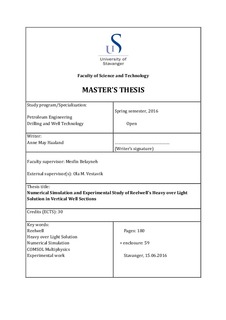Numerical Simulation and Experimental Study of Reelwell’s Heavy over Light Solution in Vertical Well Sections
Master thesis
Permanent lenke
http://hdl.handle.net/11250/2409060Utgivelsesdato
2016-06Metadata
Vis full innførselSamlinger
Sammendrag
Reelwell has developed the Reelwell Drilling Method (RDM), including the Heavy Over
Light (HOL) solution. The HOL solution allows drilling with simultaneously use of two
different drilling fluids, i.e. a near static drilling fluid with high density for pressure
control on the outside of the drill string and a lighter drilling fluid for hole cleaning
inside the dual drill string. The HOL solution implies the creation of an interface mixing
zone between the heavy and the light fluid in the well annulus outside the drill string.
The HOL solution is mainly used in horizontal sections of the well and provides
increased buoyancy which reduces torque and drag of the drill string. The solution may
also be useful in vertical wells due to the possibility of deeper setting depth for casings.
This goal for this work is to investigate the HOL solution in vertical sections of a well
through simulations using the COMSOL Multiphysics software and experimental work.
For the simulations there were defined several parameters, such as density, plastic
viscosity, and well size. The aim of the simulations was to study the effect of these
parameters on the HOL mixing zone.
The experiments were performed in vertical cylindrical tubes, using water based mud or
oil based mud with various densities and rheology properties. In some of the
experiments a pipe inside the tube was rotated to assist the mixing process. Through the
experimental work it was found that yield strength (YS) and low shear yield stress
(LSYS) has a reducing effect on the development of the mixing zone. Rotation of the
inner pipe made the fluids mix more evenly.
The COMSOL simulations indicated that density and well size affect the speed of the
development of the mixing zone, while plastic viscosity has no or little effect. COMSOL
did not prove to model the mixture process in accordance with the experimental
observations. For further work it may be desirable to further investigate the theoretical
model and to study the effect of other parameters, such as rheology properties of the
fluids, rotational force of an inner pipe and friction from pipe wall.
Beskrivelse
Master's thesis in Petroleum engineering
